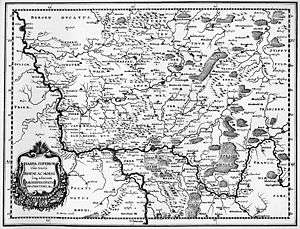Electoral Rhenish Circle

The Electoral Rhenish Circle as at the beginning of the 16th century

map of the Electoral Rhenish Circle from Topographia Archiepiscopatuum Moguntinensis by Matthäus Merian, 1646
The Electoral Rhenish Circle (German: Kurrheinischer Reichskreis) was an Imperial Circle of the Holy Roman Empire, created in 1512.
The circle derived its name from four of the seven prince-electors whose lands along the Middle Rhine comprised the vast majority of its territory.
Composition
The circle was made up of the following states:
| Name | Type of entity | Comments |
|---|---|---|
| |
County | Attained imperial immediacy in 1549 under Jean de Ligne, Principality from 1576, raised to Duchy in 1644 |
| Beilstein | Lordship | Held by the Counts of Nassau-Dillenburg from 1343 |
| |
Prince-bishopric | (Re-)established by King Otto I in 953, Prince-elector and Archchancellor of Italy in 1356; including Vest Recklinghausen and the Duchy of Westphalia |
| |
Bailiwick | An administrative grouping of lands including the immediate Lordship of Elsen, held by the Teutonic Knights |
| |
Prince-bishopric | Archbishopric established in 781 by Pope Adrian I, Prince-elector and Archchancellor of Germany in 1356; including Eichsfeld, Erfurt, and Aschaffenburg |
| |
County | Emerged from Isenburg-Isenburg in 1199, partitioned in 1502 into Isenburg-Grenzau and Isenburg-Neumagen (to Sayn-Wittgenstein in 1554), extinct in 1664 |
| |
County palatinate | Arose from the allodium of the Count palatine of Lower Lorraine in 1085 under Henry of Laach, held by the House of Wittelsbach from 1214, Prince-elector and Truchsess in 1356 |
| |
Burgraviate | Fiefdom of Cologne around Burg Rheineck, held by the Freiherren of Varsberg from 1576 |
| |
Barons | Briefadel without territory, Freiherren from 1608, Counts from 1624, raised to Princely Counts in 1695 |
| |
Prince-bishopric | Established in 902, Prince-elector and Archchancellor of Arles in 1356 |
Sources
- The list of states making up the Electoral Rhenish Circle is based on that in the German Wikipedia article Kurrheinischer Reichskreis.
External links
-
 Media related to Electoral Rhenish Circle at Wikimedia Commons
Media related to Electoral Rhenish Circle at Wikimedia Commons - Imperial Circles in the 16th Century – Historical Maps of Germany
This article is issued from Wikipedia - version of the 2/9/2016. The text is available under the Creative Commons Attribution/Share Alike but additional terms may apply for the media files.
-en.png)